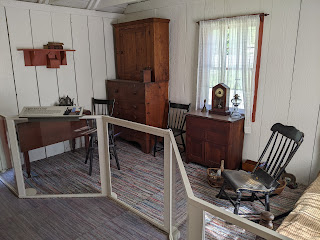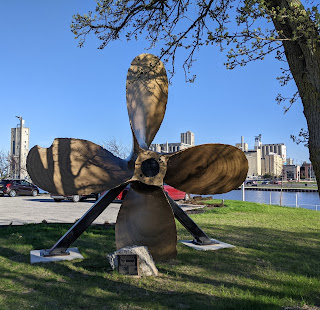A little way out of the college town of Iowa City, Iowa, was the World's Largest Wooden Nickel. Made from southern yellow pine and measuring 16 feet in diameter and weighing 4,000 pounds, it was built as a local political protest by Jim Glasgow in 2006 when locals were protesting the widening and redevelopment of the highway next to the nickel's location.
From Iowa City, we headed east to historic West Branch where President Herbert Hoover was born although we didn't head there knowing that!
Born in a modest two-room cottage, Hoover spent his first 11 years in West Branch before becoming the first US president born west of the Mississippi River. The Quaker principles of self-reliance, honesty, American individualism, and hard work were instilled in him by his parents and neighbors. I read that few American presidents have had such humble beginnings and were so authentically "self-made" as President Hoover.
"This cottage where I was born is physical proof of the unbounded opportunity of American life. In no other land could a boy from a country village, without inheritance or influential friends, look forward with unbounded hope."
With two adults and three children, there wasn't much room for furnishings in the cottage. Consider how there was even less room in the winter when the woodstove was brought inside from the summer kitchen on the back porch. The porch may have served, too, as a woodshed, storeroom, and spare bedroom.
The blacksmith's:
Quakers, including the Hoovers, strongly believed in the equal education of boys and girls. The population of West Branch was large enough to build this one-room schoolhouse that was also used as the first Quaker meetinghouse as the residents had raised much of the funds. After Hoover was orphaned at age nine, he studied at a Quaker academy near his uncle's home in Oregon before joining Stanford University's first class in 1891.
I smiled seeing how large Iowa was perceived to rank in size or importance near the end of the 19th century.
The four houses on this block of Poplar Street were here in the 1870s and 1880s when Hoover was a child. The houses were built on lots purchased by a Quaker real-estate developer who had subdivided five acres. Hoover's parents also bought a lot from the same developer.
Steven and I had actually come to West Branch only to see the Egyptian Statue of Isis, the goddess of life. We hadn't realized until we arrived in the town that an entire district had been established to honor the former president. The bronze statue symbolized Hoover's humanitarian efforts and was given to the former president by Belgians as thanks for his assistance in staving off famine in their country during WW I.
Hoover, a wealthy mining engineer, gave up his career to organize, without remuneration, a war relief group. He persuaded both German invaders and British blockaders to allow food shipments that fed millions of Belgians and French citizens. After the war ended, Hoover directed relief efforts across the continent.
When the statue was installed as part of the President's memorial landscape plans in 1939, it was positioned to face his birthplace cottage.
Mothers took infants and young children who disturbed the silence of the meeting to a small nursery called a cry room.
The building's simple architecture and plain furnishings represented Quaker values.
Our interlude in West Branch was longer than we'd planned but it had been interesting to learn how Hoover's Quaker background led to his life of service including the presidency.
The I-74 bridge over the Mississippi River connected Bettendorf, Iowa, and Moline, Illinois, two of the Quad Cities on our way to Chicago where we spent the rest of the day and the next morning visiting our almost 22-month-old granddaughter, Clara, and her dad, Adam. Our daughter, Natalie, was out of town on business so we'd have to wait until near the end of our trip in August to see her and her family again.
After an all-too-short visit with our (sweet and cute!) granddaughter, Steven told me our next stop was going to be a surprise and that I wasn't allowed to look at what the destination was on Google Maps. Steven and I were reminded yet again how lucky we are not to have to deal with any traffic congestion where we live in the Denver suburbs as we faced the miserable traffic in Chicago. It took us 90 minutes to drive just 30 miles and that was mid-afternoon on a weekend in the summertime! The thought of having to contend with that sort of Chicago traffic in the winter would be enough to send me around the bend!
I was definitely mollified, though, when we stopped at the Long Grove Confectionery in Chicago's northern suburbs as Steven knows I have a sweet tooth and he thought I'd have fun at the chocolate nirvana. Wow, did he have me pegged as it was a hit for sure but not only for me as he feasted for the next several weeks on a gigantic bag of pretzels and also on chocolate-covered pretzel rods!
Rather than heading directly to see our friends in Toronto which was our next destination, Steven and I took a roundabout route by way of the Upper Peninsula, heading due north from Chicago into Wisconsin and around two of the Great Lakes. After the sugar high from the candy store, it made sense to stop at the Mars Cheese Castle in Kenosha. For non-Americans reading this post, Wisconsin has been known as America's Dairyland since the state legislature promoted its dairy reputation by placing the slogan on license plates in 1940.
It's rather apt I'm writing this post tonight as just a few hours ago, Steven and I stopped for a few minutes at the cheese store in Moody, Maine, which was shaped like a wheel of cheese. It had a large mouse on the roof and its front door looked like a chunk of cheese had been removed from the wheel!
We next stopped by Wisconsin's Last Covered Bridge which was located in the small town of Cedarburg. I was curious why the state used to have 40 covered bridges and read that some say it was to shelter travelers in storms. More likely, however, the design preserved the truss structure, and teams of oxen used by area farmers had a fear of crossing the water on an open bridge and frequently balked.
The bridge was built in 1876 until the old landmark began a life of semi-retirement after 85 years of continuous service. When we were there six weeks ago, the bridge and adjacent Covered Bridge Park were the perfect photo ops for the high school prom.
How lucky we chose to see the bridge at the beginning of our trip as it is now closed to all pedestrian traffic following the discovery of a large crack on one of the bridge’s trusses.
We were relieved that gas cost "only" $4.19 a gallon in Sheboygan, Wisconsin, and wondered how much higher it might be as we continued our road trip for the next three months. Also in Sheboygan, was America's tallest flag, described as the "world's tallest tribute to freedom." We'd hoped to see the 400-foot-tall flagpole (about 100 feet taller than the Statue of Liberty) waving a four-story tall 7,200-square-foot American flag at an insurance company campus. However, it was only at half-staff to honor the one million Americans who have died from Covid so far.
The views once we reached the city's North Point Park on the shores of Lake Michigan, one of the five Great Lakes, were just beautiful. As lovely as the views were, the temperature, though, had dropped from a high of 85 degrees in suburban Chicago to just 69 degrees here by the lake.
We had no clue that the exposed shelf of rock or bedrock at North Point was a rarely occurring geologic formation along the Lake Michigan shoreline. Known as Niagara limestone, it was part of the same bedrock course as the outcropping in New York which forms Niagara Falls!
Anyone looking to buy a house? There was the most unusual one in the shape of an igloo or mushroom in Manitowoc!
Another nod to America's Dairyland in Manitowoc!
Briess is a leading manufacturer and marketer of malted barley and other natural specialty ingredients for the city's craft beer industry.
Across from the city's vibrant River District was a submarine in the 35-mile-long Manitowoc River. A historical plaque near the Wisconsin Maritime Museum stated that at the beginning of WW II in 1939, a goal for President Franklin D. Roosevelt was to increase the number of submarines. As existing shipbuilders were unable to meet production schedules, the president of the Manitowoc Shipbuilding Company was asked by the US Navy to build submarines. Workers and engineers quickly developed innovative construction methods and by employing 7,000 workers in three shifts, working seven days a week, built 28 fleet submarines. One of the Manitowoc subs, the USS Rasher, sank almost 100,000 tons of Japanese shipping, the second-highest for any American-made sub. Four Manitowoc subs and 336 officers and enlisted men perished during the war.
Our final destination in Manitowoc was actually the only reason we'd originally decided to come to the city until we found so much more that appealed to us - finding the spot where part of Sputnik IV landed when Russian scientists launched the 5-ton spaceship on May 15, 1960! It was the first Sputnik with a pressurized cabin and life support equipment for the planned manned program. After four days of flight, the reentry cabin was separated from its service module and retrorockets were fired. A bug in the guidance system had pointed the capsule in the wrong direction, so instead of dropping into the atmosphere, the satellite moved into a higher orbit.
Transmission of temperature and pressure data from the erratic satellite continued until September of 1962 when the spacecraft began a slow plunge to Earth. At about 4:30 am Central Standard Time on September 5, 1962, a 20 by 8 cm piece hit almost precisely on the center line of North 8th Street, near the intersection of Park Street in Manitowoc. The impact of the piece embedded it three inches in the blacktop pavement. Later, small charred fragments were found on a nearby church roof, but despite an intensive search, no other fragments of Sputnik IV were ever found.
Officials at NASA and the Smithsonian Institute identified threads arranged in the metric system, and the detection of two minerals created by the heat and friction of re-entry: wustite and akaganeite. After the Manitowoc Common Council accepted two replicas of the Sputnik IV made by NASA in September of 1963, the spot on North 8th Street where Sputnik IV landed was permanently marked! The above information is summarized from local sources.
Manitowoc had proved to be far more exciting than we initially thought and certainly would be worthy of another visit when we have more time to do the area justice. That day, however, we needed to drive another 40 miles further north to Green Bay, also in Wisconsin.
Next post: Driving the Upper Peninsula's Lake Michigan Circle.
Posted on July 2nd, 2022, from Middleboro-Plymouth, Massachusetts, more or less halfway between mid-coast Maine where we've just spent three marvelous days on an island off the coast, and Brooklyn, New York, where we're seeing our eldest child and her husband beginning tomorrow for three days.





















































Boundless opportunities in America as per President Hoover ("In no other land could a boy from a country village, without inheritance or influential friends, look forward with unbounded hope.") a "cry" room for disruptive babies, and the final resting place of Sputnik IV.. what a great historical accounting of West Branch, Iowa and Manitowoc , Wisconsin. xo
ReplyDeleteThanks, Lina, for being such a faithful reader AND commenter on the posts!
ReplyDelete